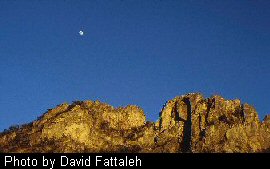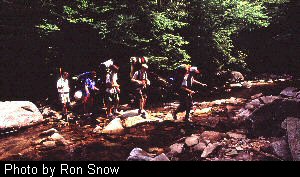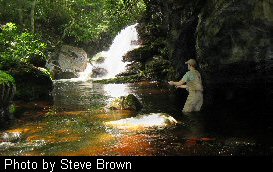

|
This Land Is Your Land: West Virginia 's Public Lands and Waters By Steve Brown
While this may seem to be an impressive array, West Virginia 's public land acreage is actually below average for other states in the region. We have, however, come a long way in a short time. A century ago, virtually none of our natural resources were in the public domain. Decades of unregulated timber harvest, mining and pollution had scarred the face of the state and decimated its fish, wildlife, and other natural resources. In West Virginia and nationwide, the public outcry for resource conservation led to passage of state and federal legislation to acquire, protect and publicly manage some special places. They included forestlands, mountains, rivers, waterfalls, geological features, wetlands and habitats for unique assemblages of plant and animal species. The first extensive acquisition of public lands in West Virginia began in the 1920s with purchases for the national forests. The U.S. Forest Service would manage the land for the long-term conservation of their timber, watershed, fish and wildlife resources as well as public recreational benefits such as camping, hiking, hunting and fishing. These acquisitions have since grown to include 1.2 million acres in three national forests, the Monongahela, Jefferson and George Washington. National forest lands comprise approximately 68 percent of the acreage of public lands and waters in West Virginia and some of our most spectacular scenery. Close on the heels of national forest acquisitions came the establishment of West Virginia 's state park and forest system. The first state park, Droop Mountain , was established in 1929. By the mid-1930s, other major parks and forests were being acquired and developed to preserve unique resources and to provide public recreation.
In late 1930s, the West Virginia Conservation Commission, forerunner of today's Division of Natural Resources, began to acquire lands and waters expressly to conserve and manage their fish and wildlife resources and to provide public hunting and fishing opportunities. Elk River Wildlife Management Area, the state's first, was established in 1938. It has subsequently been joined by other purchases across the state that collectively total about 200,000 acres of wildlife habitat, or 11 percent of the state's public recreation lands. An additional 87,000 acres are leased by the state and managed as WMAs. The WMAs are unique in that they give DNR biologists direct opportunities to do hands-on management for the principal purpose of improving fish and wildlife populations. In addition to the national forests, the federal government has made several other significant public land acquisitions in the state. Constructed over the last half century, U.S. Army Corps of Engineers reservoirs are the state's primary sites for flatwater recreation such as boating and angling. In most cases, the surrounding lands have been purchased by the federal government and are being managed by the DNR as WMAs. More recently, federal purchases of lands and waters for the New River Gorge National River and the Ohio River Islands and Canaan Valley National Wildlife refuges have increased outdoor recreation opportunities for the public while protecting unique wetlands, wildlife and spectacular viewsheds. Taken together, these federal acquisitions have added about 198,000 acres, or an additional 11 percent, to the total acreage of public recreation lands in the state. Some of the state's truly special places are found on this array of public lands. From Seneca Rocks to Cooper's Rock, the Ohio River Islands to the New River Gorge, Lost River to Elk River, West Virginia's public lands offer a unique diversity of plants and animals, eye-popping scenery, and wonderful recreational opportunities. They are among the most heavily visited, frequently photographed and best remembered tourism destinations in the state. Hunters, anglers and other wildlife recrea-tionists are one of the largest single components of the tourism picture on public lands. More than 71,000 hunters, 156,000 birdwatchers, hikers and nature photographers, and more than 300,000 anglers recreate on our public lands and waters each year. The economic impact of expenditures for travel and equipment associated with wildlife recreation on public lands is about $350 million annually.
A 1998 public opinion survey conducted by Responsive Management, of Harrisonburg, Virginia statistically quantified the strength of West Virginians' attachment to our public lands (see graph on left) . Responsive Management's report indicated that these were some of the highest numbers that they had seen in similar surveys conducted across the nation. It takes more than acreage statistics and economic analyses to explain this deep commitment of West Virginians to the state's public lands and waters. Perhaps a better explanation is that these places are havens. They were, and in many cases still are, biological havens in an often-overexploited landscape. Over the years, they have also become another kind of haven, a haven for people to recreate, to renew themselves, and to reconnect with wildlife and other natural resources. They are a haven for the spirit in a too rapidly changing world. For most West Virginians , public lands are the Wild and the Wonderful , in Wild, Wonderful West Virginia . Steve Brown is a wildlife planner stationed in Elkins. |


